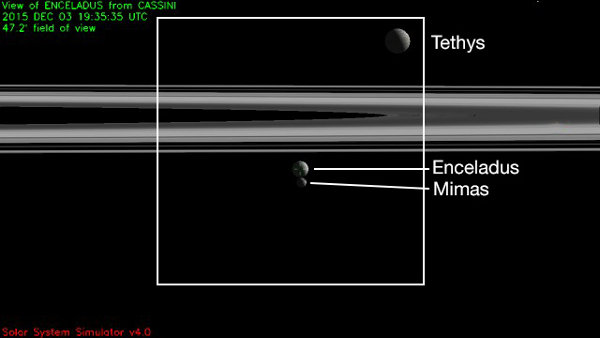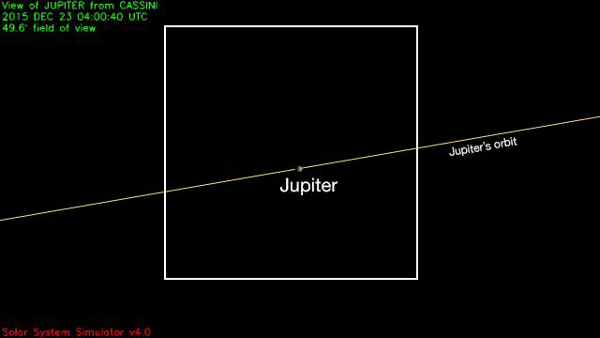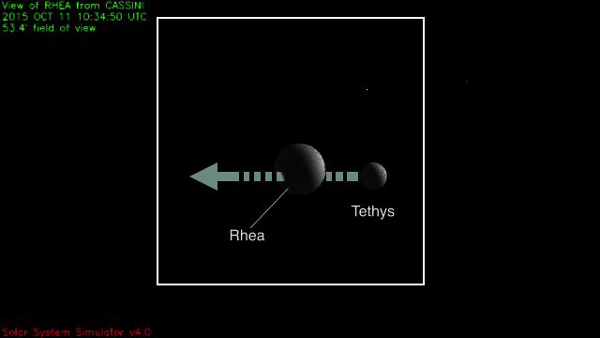Cassini Scientist for a day competition 2015 – targets
Which of these targets would you choose?
Software used by the Cassini science planning team simulates the field of view the cameras on board the spacecraft can capture at a specific date and time. Mission planners use computer-generated images like those below to plan observations.
1. Saturn's rings, with three of Saturn's moons: Tethys, Enceladus, and Mimas.
 |
| Target 1. Credit: NASA. |
This image combines a slice of Saturn's beautiful rings with three of Saturn's moons: Tethys at the top, Enceladus just below the rings, and Mimas below Enceladus.
Tethys was discovered in 1684 by Giovanni Cassini. It is mostly made of water ice, which means that it has a very low density. The surface of this mid-sized moon is heavily scarred with craters and large fault lines.
Enceladus is the sixth-largest moon of Saturn. Because it is covered in ice, its surface reflects nearly 100% of the sunlight that reaches it. William Herschel discovered this moon in 1789, but little was known about Enceladus until the two Voyager spacecraft flew past in the 1980s. Since then, the Cassini spacecraft has observed water geysers spouting out of the moon, spreading particles throughout the E-ring of Saturn’s ring system and bombarding the other moons that are found there, such as Tethys.
Tiny Mimas, the smallest of Saturn’s major moons, is a frozen scarred world. It has one of the most cratered surfaces in the Solar System. A distinctive giant impact feature is named Herschel after William Herschel, who discovered the moon in 1789.
Saturn is famous for its stunning ring system. There are seven concentric rings surrounding the planet. They are composed of many icy and rocky particles that range in size from that of a grain of sand to that of a house, each travelling in their own orbit. The rings of Saturn have baffled astronomers since Galileo Galilei discovered them in 1610.
To find out more about this target view the information on the NASA 'Cassini Scientist for a Day' competition pages.
2. A distant image of Jupiter.
 |
| Target 2. Credit: NASA. |
Jupiter is the largest planet in the Solar System. It is so big that more than 1000 Earths would fit inside. The average distance between Saturn and Jupiter is an incredible 645 million kilometres; therefore, despite its immense size, from Saturn, Jupiter will just look like a small dot through the eyes of Cassini’s cameras.
Why would a spacecraft orbiting Saturn want to take a picture of Jupiter from so far away? Images of Jupiter from Saturn are of high interest to scientists planning future space-based instruments that will study exoplanets.
To find out more about this target view the information on the NASA 'Cassini Scientist for a Day' competition pages.
3. A short movie of Saturn's moon, Tethys, passing behind Rhea.
 |
| Target 3. Credit: NASA. |
This movie of Tethys passing behind Rhea will be stitched together from 27 images taken 60 seconds apart. Why do we do this? Because Cassini doesn't have a video camera on board.
Rhea is the second largest of the moons of Saturn. It is another small, cold, and heavily cratered world that consists of three quarters water ice and one quarter rock. This moon is covered in wispy lines that can be tens to hundreds of kilometres in length. Cassini images have shown that these wispy lines are subsidence fractures that make deep canyons.
To find out more about this target view the information on the NASA 'Cassini Scientist for a Day' competition pages.
